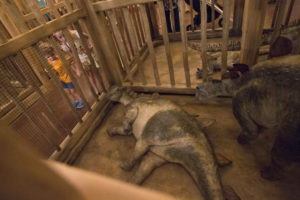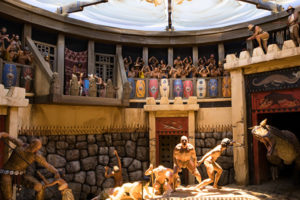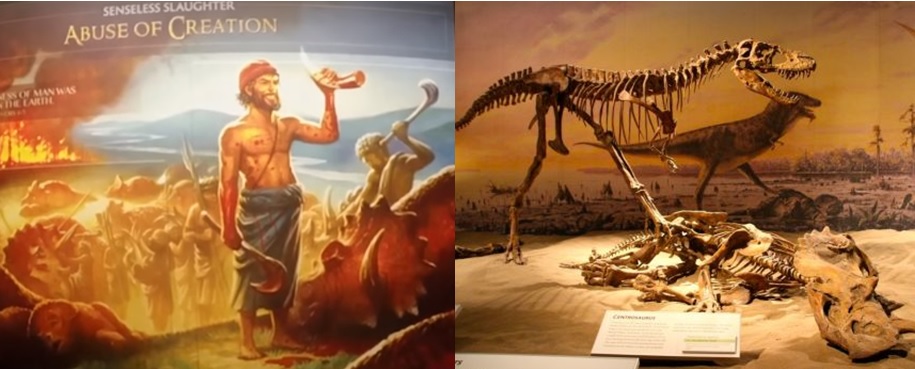 It’s a year and a day since Ken Ham’s dream came true: Noah’s Ark set sail. A full-sized replica, that is, and it didn’t actually set sail, just got itself beached on dry land, with rural Kentucky standing in for a dramatically flattened Mount Ararat. But after a year in operation, there is some controversy about how well Ken Ham’s Ark Encounter is doing. Is it sinking, or will it stay afloat? Is it benefiting the surrounding townships, or is it an expensive folly?
It’s a year and a day since Ken Ham’s dream came true: Noah’s Ark set sail. A full-sized replica, that is, and it didn’t actually set sail, just got itself beached on dry land, with rural Kentucky standing in for a dramatically flattened Mount Ararat. But after a year in operation, there is some controversy about how well Ken Ham’s Ark Encounter is doing. Is it sinking, or will it stay afloat? Is it benefiting the surrounding townships, or is it an expensive folly?
Now, I have not been to the Ark Encounter, and I doubt I ever will, but a reasonably good idea of the ambience and exhibits can be gained from its website and walkthroughs on youtube. Yep, it’s big. And incredibly spacious, with apparent acres of gleaming hardwood floors, enough amphorae to keep the Roman army drunk for a year, and cages—lots of cages. The murals are in two major modes: Jack-Chick Moderne, and the style of the Sunday school papers I used to be given as a kid. The muzak is exactly like the stirring, endlessly looping melodies that form the background to computer games. The decor of Noah’s living quarters is an IKEA version of the Arabian Nights, with a dash of Conan the Barbarian. And the exhibits—oh, the exhibits!
Oddly enough, there are so many dinosaurs on display that you’d think the Garden of Eden was located in  Jurassic Park. Numerous transitional fossil species from across the geologic ages have been coopted as “kinds,” the lynchpin of Ken Ham’s post-flood scenario: he asserts that, once the Ark landed, each of these pairs speciated at lightning speed into the wide and varied animal kingdom of today. One can only imagine the frenzied pace of postdiluvial sex—no wonder life expectancy dropped.
Jurassic Park. Numerous transitional fossil species from across the geologic ages have been coopted as “kinds,” the lynchpin of Ken Ham’s post-flood scenario: he asserts that, once the Ark landed, each of these pairs speciated at lightning speed into the wide and varied animal kingdom of today. One can only imagine the frenzied pace of postdiluvial sex—no wonder life expectancy dropped.
Noah and his family are given back-stories that are pure invention, aka “artistic licence.” Apparently they had only 850 animals each to look after every day, which is why they could spend a lot of time lounging around in their luxury quarters in suspiciously clean clothes. (As one who found twelve chickens and a few cats to be a strain, I am full of admiration.) Fabulous technological fixes are suggested for the problems of waste disposal, lighting, and air circulation, though evidence for any of them is lacking.
 All of this, and much much more of a similar nonsensical nature, is disseminated around the Ark on posters and plaques—there’s a lot of reading to be done. Indeed, there is more to read than to see. The animals are plastic and resin figures. There is nothing interactive. The coolest exhibit (to me) consists of detailed miniature dioramas of rather lurid Sin happening in the antediluvial world, which the kids are naturally not allowed to touch. In fact, I’m a little surprised they’re not X-rated. Anyway, this brings me to an overview of the critical reviews on sites like yelp and tripadvisor.
All of this, and much much more of a similar nonsensical nature, is disseminated around the Ark on posters and plaques—there’s a lot of reading to be done. Indeed, there is more to read than to see. The animals are plastic and resin figures. There is nothing interactive. The coolest exhibit (to me) consists of detailed miniature dioramas of rather lurid Sin happening in the antediluvial world, which the kids are naturally not allowed to touch. In fact, I’m a little surprised they’re not X-rated. Anyway, this brings me to an overview of the critical reviews on sites like yelp and tripadvisor.
The majority of visitors give the Ark Encounter four or five stars out of five, but there was a substantial minority of pissed-off people. By far the greatest dissatisfaction (even in some of the five-star reviews) centred around two issues, the first being the inordinate amount of cash required to “encounter” the Ark: admission is about forty bucks per adult, nearly thirty per kid, and no family discounts. Parking is ten bucks extra. The zip-line and the camel/donkey rides are not included. The food, by most accounts, is both expensive and dismal. And after all that, once the impact of the sheer size of the “ship” is past, the Ark Encounter is—boring.
Impressive from the outside? Yes. Worth all the money? No. As you can see from other reviews some of us find this place way overpriced. The highlight of my visit was the view when you first see it & when you enter the bottom of the ship with all the sound effects of a storm approaching. Other than that the exhibits were hard to view, people pushed into tight spaces to try to read the small print or get photos & bored to death kids running around because there was nothing else for them to do.
The zoo is somewhat of a huge disappointment. I’m not sure what I expected, but they had several kangaroos, a few llamas and some ostriches…. And that’s it! I don’t know if they’re still adding to the attraction, but it was abysmal. My 2 1/2 yo did love riding the camel but it was $16 for about 2 minutes for 2 of us. For the kiddo it was worth every penny, but you decide.
Quite frankly a waste of money. I traveled from Louisiana en route to our final destination in Indiana. We went out of the way to check out the ark and were terribly disappointed. The ark itself was structurally impressive, but that was about it. Way over-priced, sparse exhibits of interest, and extreme religious propaganda (and I say that even being a Christian). There was literally nothing to do once in the ark area, and I left wanting my money back. Only port-o-potties in the ticketing area and no air conditioning while you wait. We regretted adding the extra hours to our trip.
[My favourite review] The staff was nice, maybe overly so. I was blessed at least 12 times. Frankly 5 was enough. Food was too expensive although there is a great deal on kettle corn.
Clearly, the Ark Encounter is not yet ready to take on Disneyland. Perhaps better to compare it with another place that has lots of dinosaurs, an educational remit, and a claim to be “world-class”: the Royal Tyrrell Museum of Paleontology in Drumheller, Alberta. A few points of comparison:
ADMISSION
Ark Encounter: Adults $40, Seniors (60+) $31, Children (5-12) $28, Children under 5 FREE. Parking: $10
Royal Tyrrell: Adults C$18 [US$14], Seniors (65+) C$14 [US$11], Youth (7-17) C$10 [US$7.80], Children 6 and under FREE. Family rate of 2 adults plus up to six children: C$46 [US$36] Parking: Free
CAPITAL COST
AE: about 100 million USD
RT: about C$30 million in 1985, roughly equivalent to C$61 million or US$48 million in 2017.
EXHIBITS AND ACTIVITIES
AE: Fake animals.
RT: Real fossils. [Casts are used in a few cases where the fossils are too large or fragile for display.]
AE: Animatronic Noah answering pre-set questions; mannequins at work and prayer.
RT: Real paleontologists working on real fossils in a real lab, visible through a glass wall.
AE: Dioramas and murals showing dinosaurs being slaughtered by rapacious humans and fighting giant gladiators in arenas in front of bloodthirsty crowds.
RT: Dioramas and murals showing dinosaurs and articulated fossils in their natural habitats, based on geological and paleontological evidence.
AE: The Mining Sluice and Fossil Find, an activity for children. Ten bucks buys a bag of dirt salted with cheap mixed fossils. The kid dumps the bag into a screen and washes the dirt away in the sluice. The kid gets to keep the fossils. The activity takes two minutes, tops.
RT: A wide range of hands-on activities from fossil-casting to simulated excavations and guided hikes through genuine fossil beds. Downloadable gallery worksheets. Activity boxes.
STAFFING
AE: Staff who have signed a statement of faith in creation science and rejection of evolution, plus reportedly a chastity pledge if unmarried.
RT: Respected paleontologists involved in active research, both locally and globally.
Quite apart from the fact that the Ark Encounter deals in arrant pseudoscience while the Royal Tyrrell deals in  paleontology, it seems obvious that the latter gives more bang for the buck. I know which one I’d rather visit with an inquisitive seven-year-old, even if my only motive was to keep the kid entertained for a few hours. Clearly, the Ark is out for profit, while museums like the Royal Tyrrell are out to educate. Of course, the Ark Park is going for a different market, and I would not be as quick as some to predict it will be a commercial failure; I think it’s too soon to tell if the Ark is on a collision course with the bottom of the fiscal sea.
paleontology, it seems obvious that the latter gives more bang for the buck. I know which one I’d rather visit with an inquisitive seven-year-old, even if my only motive was to keep the kid entertained for a few hours. Clearly, the Ark is out for profit, while museums like the Royal Tyrrell are out to educate. Of course, the Ark Park is going for a different market, and I would not be as quick as some to predict it will be a commercial failure; I think it’s too soon to tell if the Ark is on a collision course with the bottom of the fiscal sea.
Among the multitudinous complaints about ripoff prices and general disappointment with the Ark, there are glowing paeans to it as a vindication of young-earth creationism and the Christian message. There’s the guy who was unhappy it didn’t exhibit artifacts from the original Ark, but he was willing to let that pass. There were several that were delighted to find the original Ark had not been the dismal stinky cesshole they thought it was, but that God had essentially sent his chosen survivors on a nice cruise. Numerous visitors seemed to think the Flintstone-ish high tech solutions to remove waste products and keep the inhabitants of the Ark from getting gassed to death were based on research and evidence, rather than raw imagination. This is confirmation bias in action.
Unfortunately, all of that cuts to the heart of why I think the Ark Encounter will probably prosper in due course, and equally why it will be a travesty if it does. To those of us who can tell the difference between science and ideology, the Ark Encounter is a waste of perfectly good wood. It disseminates not just rubbish, but lies; it disseminates fantasies and fictions under the rubric of “artistic license,” but must know that patrons with the will to believe will remember the museum’s fictions as fact. And that is doubly a tragedy when the indoctrination of children is involved.


